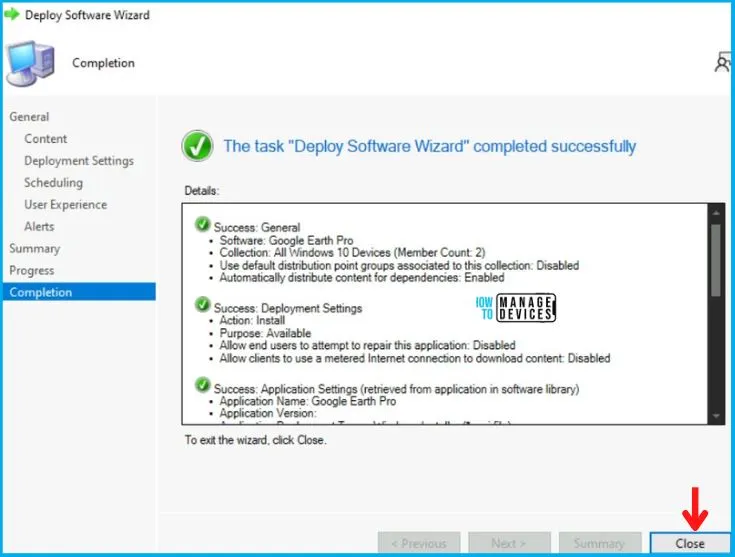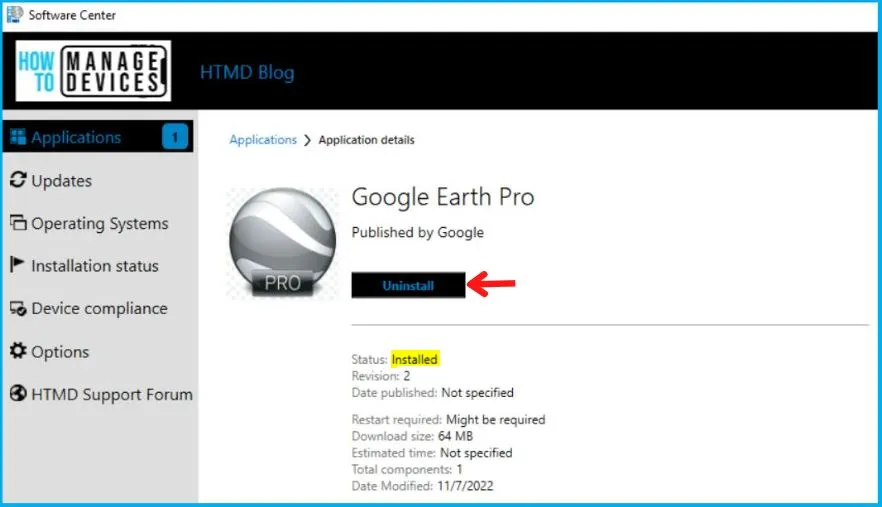In this post, we will be deploying Google Earth Pro Using SCCM Application MSI Model. We will make use of the MSI application to deploy Google Earth Pro using SCCM on Windows 10/11 client machines.
The desktop version of Google Earth Pro is free for users who require advanced features. You can export and import GIS data, and you can go back in time with historical imagery. This software is available for Windows, macOS, and Linux systems.
In this program, satellite images, aerial photographs, and GIS data are superimposed onto a 3D globe, allowing users to see cities and landscapes from different perspectives. Using a keyboard or mouse, users can explore the globe by entering addresses and coordinates.
If available, the MSI application is the best method for deployment on client machines using SCCM. As stated in the beginning, here we are using the MSI application for the deployment of Google Earth Pro.
- Cjwdev Group Manager Deployment using SCCM | 0x643 1603 Error
- Deploy WinMerge using SCCM | Fix software could not be found Issue
What is an MSI file?
Windows packages that contain installation information, including files to be installed and installation locations, are called MSI files. The EXE and MSI files both install and launch Windows programs.
The EXE file may not always contain an installer and may launch its program when double-clicked. An MSI file, however, always includes an installer.
Google Earth Pro Install Uninstall Commands
Let’s start with the Deployment of Google Earth Pro using SCCM. As told earlier, we are using the MSI file for Google Earth Pro Deployment. You will see why the availability of MSI files for any application brings sparkles in the eyes of the SCCM Admin.
But here is a catch!! Google Earth Pro’s MSI is not available directly. Here we will try to retrieve the MSI file of the Google Earth Pro from its EXE file. For this, you first need to download the EXE file from Google Earth Pro. One can easily distinguish and download the 64-bit Architecture windows based application.
Now to retrieve the MSI file you need to follow some specific steps. It hardly gives you 2 to 3 seconds to copy the MSI file. As shown below in the image, you need to open this path:
- Users\CurrentUser\AppData\Local\Temp
Now as you keep handy the above path, it is this place where MSI will be visible as soon you double-click on Google Earth Pro setup. So it is advised to keep both windows side by side as shown below. And copies the MSI setup as soon as it appears at another location. Bingo!!!!

Now as we get the MSI, we don’t need to work on prerequisites as we used to tell you in the previous posts in which we used EXE files.
- All we have to do now is download the logo of Google Earth Pro, as we already extracted the MSI file.
The following table gives you all the details required for the Google Earth Pro Deployment tool using SCCM. This includes the command line for Google Earth Pro silent install, Uninstall, and Product Code.
| Name | Install Command Line | Uninstall Command Line | Detection Method |
|---|---|---|---|
| Google Earth Pro Deployment Tool – Windows Installer (*.msi file) | Install -> msiexec /i “GoogleEarth-EC-x64.msi” /q | Uninstall -> msiexec /x {43C465DA-7E4C-4C8E-91C1-A0FABB951751} /q | Windows Installer – {43C465DA-7E4C-4C8E-91C1-A0FABB951751} |
- Deployment of Amazon WorkSpaces using SCCM | MSI Application Guide
- Bitwarden Deployment Using SCCM | Deploy EXE File
Google Earth Pro Application Creation Using SCCM Console
This MSI application deployment guide will use the SCCM admin console to create an application. To start with the Application creation part, copy the downloaded setup to the package source location of the SCCM Server.
- Navigate to SCCM Console\Software Library\Overview\Application Management\ Applications.
- Right-click on Applications and select Create Application.

For all MSI application deployments, always Select the Automatically detect Information about the application from installation files and choose Windows Installer (.msi files) in the Type category. Also, enter the UNC Path for the application in Location and click Next as shown below in the image.

Now you will see the real Magic!!! As soon you click on next, you will see that all the information has been imported from the MSI file as shown below, and click Next.

Also in the General Information Tab shown below, you will see it imports the install behavior/command from the installer itself.
- Silent Command Line for Google Earth Pro = msiexec /i “GoogleEarth-EC-x64.msi” /q

After this, click Next on the Summary Tab and end this Create Application Wizard by clicking on Close in Completion Tab.

After the creation of the Application, it will appear in the Application Node. Now to Add an Icon to Google Earth Pro, right-click on Google Earth Pro and click on Properties.
After this choose Software Center Tab as shown below. And click on Browse in Icon, select the icon, and click on Apply and OK, as shown in the image below.

Distribute Google Earth Pro Application
After the creation of the Application, it will appear in the Application Node. To begin with, the distribution right-clicks on the Google Earth Pro Application and clicks on Distribute Content, as shown in the picture below.

Now the Distribute Content Wizard will open, and click Next in the General Tab. Then select the Application Name in the Content Tab and Click on Next, as shown in the image below.

After this, in the Content Destination Tab, Click on Add and select the Distribution Point option.

Then Add Distribution Point page will pop up, choose the Distribution Point on which you want to distribute the Application and click on OK, and then on Next.

After this, Click Next on Summary Tab and complete this Distribution process by clicking Close on Completion Tab.

Deploy Google Earth Pro using SCCM
So as of now, we have accomplished two tasks i.e., Application Creation and Application Distribution to the DP. Now all that is left is the Deployment of the Google Earth Pro on the All Windows 10 Device Collection.
As you can see, your Application is displaying in Application Node, Right-click on Google Earth Pro and select Deploy.

After this, Deploy Software Wizard opens, and in the General Tab, enter the Name of the Application and click on Browse to select the Collection.

Now the Select Collection page will pop up; choose Device Collection from the drop-down menu, and then
- Select your targeted Device Collection and click on OK, and then Next.
- Here I choose All Windows 10 Devices.

Now in the Deployment Settings Tab, select:
- Install in the Action box
- And choose Available in the Purpose category.

In the Scheduling Tab, enter the time details if you want it to be available at a specific time; otherwise, leave it as it is and click Next. After this, in the User Experience Tab,
Select Display in Software Center and shows all notification options in the User notifications, and click on Next as shown below.

In the Alerts and Summary Tab, click on Next and to end the process, click on Close in the Completion Tab.

Time to log in to Windows Machine
In this section, we will check the end-user experience for Google Earth Pro Application Deployment and Installation. The Google Earth Pro Application is Created, Distributed, and Deployed.
Now, if you check the Software Center of Win 10 device from the Windows 10 Device (or All Windows 11 Device) Collection, you will see the Application in Available Mode, and the user can install it as per the requirement.

As you can see in the below screenshot, the Google Earth Pro Application is installed successfully on Windows 10/11 devices. This proves that the above MSI installer works fine for Google Earth Pro Application Installation using SCCM.

So the above picture depicts that we have finally created, Distributed, Deployed, and Installed the Google Earth Pro Application shown in the Software Center as shown in the above image.
Author
Abhinav Rana is working as an SCCM Admin. He loves to help the community by sharing his knowledge. He is a BTech graduate in Information Technology.
